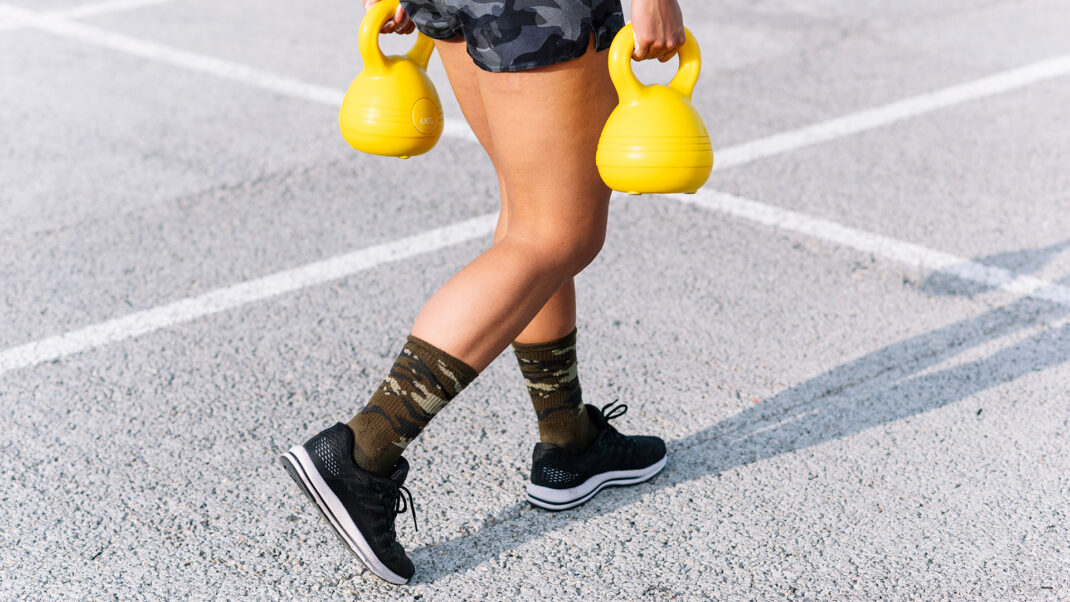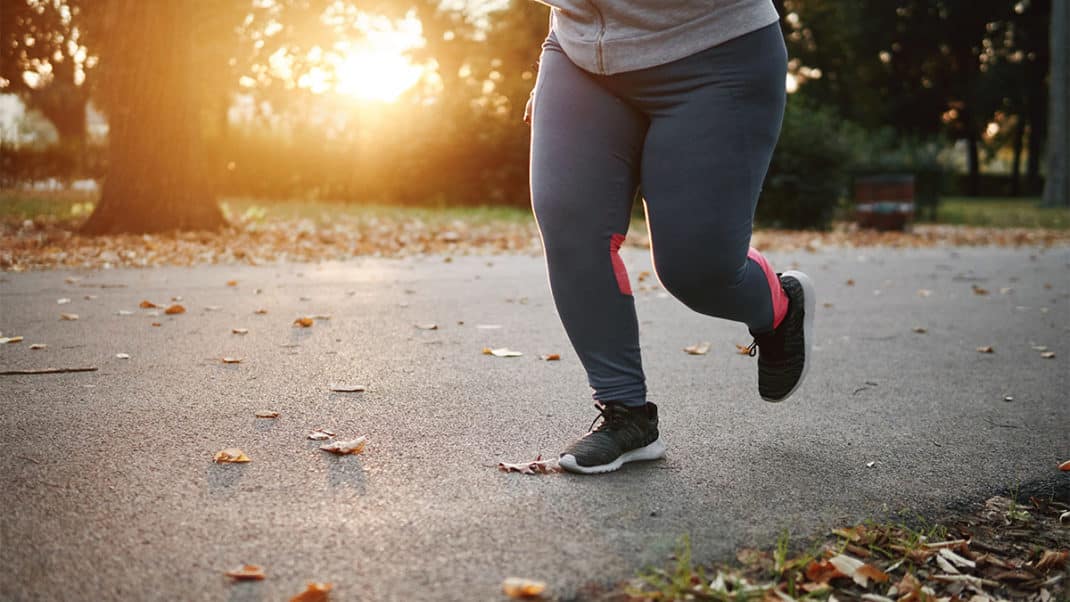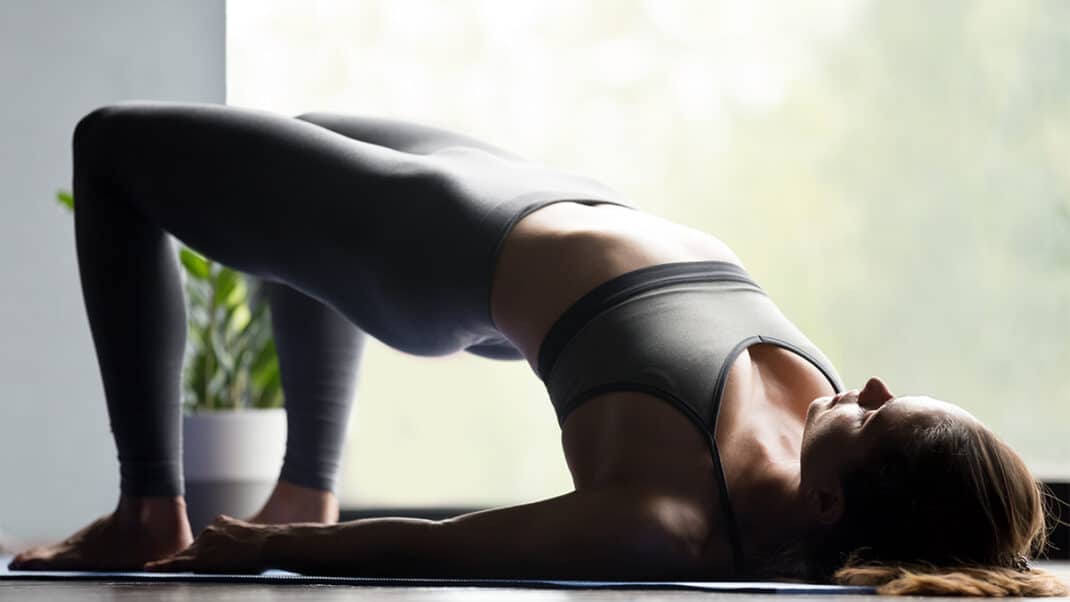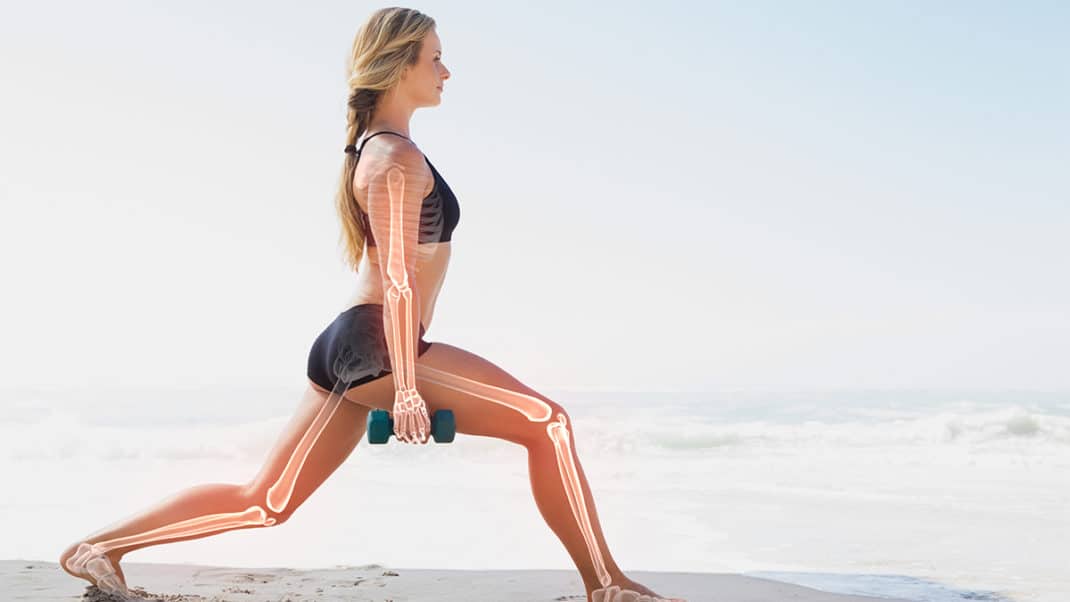6 Reasons to Include Loaded Carries in Every Client Program
Learn the benefits of loaded carries and techniques for including them in your programming.

Whether it is carrying groceries, moving furniture or partaking in an activity for fun, carrying things is part of our everyday lives. Carrying requires some amount of strength and by now, most people recognize the following benefits of strength training and loaded carries:
- Strengthens and maintains muscles and bones: strength training positively stresses muscles and bones, causing them to increase mass and density over time (Mayo Clinic 2023).
- Helps manage weight: strength training can help a client manage or lose weight by increasing their metabolic rate and subsequently burn more calories (Mayo Clinic 2023).
- Enhances quality of life: strength training can help improve a client’s ability to do everyday activities without pain, injury or difficulty (Mayo Clinic 2023).
- Reduces change of chronic conditions: strength training reduces the chance of chronic conditions like arthritis, heart disease, obesity, depression and diabetes (Mayo Clinic 2023).
- Sharpens thinking skills: strength training can also improve and maintain cognitive function (thinking and learning skills), especially for older adults (NIA 2020).
Loaded carries are a group of exercises that can help improve clients’ ability and confidence to perform everyday activities that involve carrying things. They are a beneficial exercise to include in any client’s program as they improve full-body strength, performance, and overall health and longevity.
The Lowdown on Loaded Carries
Loaded carries are performed by carrying a weight over a certain distance. There are several types of carries, including:
- Farmer’s Walk (or farmer’s carry): consists of walking with weight (such as dumbbells) in each hand.
- Suitcase Carry: a farmer’s walk in which the weight is carried in just one hand.
- Waiter’s Walk (or press walk): the load is held overhead with a straight arm-typically using one arm, but it can also be performed with two.
- Cross Walk: a farmer’s walk with one hand and a waiter’s walk with the other.
- Offset Carry: similar to either a cross walk or a farmers walk, but with different amounts of weight in each hand. For example, 20 lbs in one hand and 40 lbs in the other.
- Rucking: walking with extra weight either in a backpack or as a weighted vest.
See also: Training for Everyday Athletes
Benefits of Loaded Carries
Loaded carries are a full body exercise that not only promotes all the benefits of strength training, but also introduces performance and longevity benefits, including:
- Practicality
- Increasing exercise capacity
- Improving grip strength
- Helping posture
- Strengthening the core
- Boosting shoulder health
1. Practicality
Any training program should not only improve clients’ health but also their everyday quality of life. Loaded carries are perfect for this as they are practical, meaning their benefits transfer to everyday life outside of the gym. The benefits transfer because the exercise requires similar movement, strength and stability of everyday activities, such as carrying packages, moving furniture or bringing the groceries in from the car. Therefore, progress in loaded carries directly transfers to improvements in clients’ ability to perform everyday activities and reduces the chance of injury when performing them.
Carrying things is a skill. There is a proper way to carry things and an alternative way that makes one more vulnerable to injury. Clients will improve their skill and confidence in carrying things in their everyday life when they perform loaded carries with proper technique (described below).
2. Increase Exercise Capacity
If your client wants to save time, improve total-body strength, and increase their exercise capacity, then loaded carries are a great exercise to include in their training. Exercise capacity is defined as, “the maximum amount of physical exertion that a patient can sustain” (Goldstein 1990). In other words, exercise capacity is the total amount of training a client can perform (sets and reps), recover from, and positively adapt to.
Loaded carries are a great way to improve exercise capacity because they require the use of many different muscles in the upper and lower body. This requires the heart and lungs to work at a higher rate to effectively pump oxygen-filled blood to multiple muscles throughout the body (Nystoriak & Bhatnagar 2018). Some of these muscles include those of the forearm, deltoids, trapezius and other upper back muscles, the core, quadriceps, hamstrings, glutes and calves.
Since these exercises require the use of most of the body, the heart and lungs must work harder than they would if exercising only a single muscle group. This makes loaded carries a great exercise to work multiple muscles, as well as the heart and lungs, at a taxing rate for a short amount of time.
3. Improve Grip Strength
A strong grip has been found to be correlated to lower mortality and is an indicator of better overall health and quality of life. For instance, one study found that a weak grip was a predictor for accelerated decline in performance of everyday activities and cognition, resulting in an increase in dependency at an old age (Musalek & Kirchengast 2017). Another study observed that older men and women who performed well on a grip strength test had significantly better health and quality of life, over other men and women their age who performed worse on the grip test (Taekema et al. 2010). This suggests that grip strength is important for the maintenance of overall health and longevity for a client of any age, but especially for those who are older.
Grip strength is also vital in any sport, the gym and everyday life, because most sport skills, exercises, and everyday activities require the use of the hands and grip. Whether someone is wrestling, carrying groceries or lifting a dumbbell, they will need their grip. Loaded carries improve grip strength, which in turn will help any client reach their goals.
4. Helps Posture
Loaded carries help improve posture, as they strengthen the core and upper back muscles that keep the shoulders retracted and core muscles stable. As a result, loaded carries help reverse or mitigate the improper posture of slouched shoulders and a rounded upper back, which has become a problem in our modern society due to excessive sitting and staring at screens (Singla 2017).
A helpful cue for clients to maintain proper posture when performing a loaded carry is to pull their shoulder blades back and down (NFPT 2023). This cue will ensure that clients open and lift their chest. This cue also activates the muscles in the upper back, ensuring proper stability in the spine and shoulders.
As clients progress in loaded carries, they will strengthen the muscles that support posture, practice proper posture, and mitigate or reverse the effects of rounded shoulders and back caused by modern society’s lifestyle.
5. Strengthen the Core
The core consists of all the muscles that support the spine. Core training should consist of more than sit-ups and crunches (Better Health Channel 2021), because these exercises neglect many of the muscles that are responsible for bracing and supporting the spine when lifting, such as stabilizing it under a heavy barbell.
Loaded carries help to strengthen the whole core, because they require stabilization to protect the spine and keep the body in a strong, upright posture. For instance, loaded carries require clients to stabilize with their core because the additional weight shifts as they walk. Stabilizing their core ensures they do not fall over, are in a strong position, and are practicing proper technique. Loaded carries can teach clients (mentally and physically) to properly use their core to brace, subsequently stabilizing their spine as they move, lift and carry. This practice of bracing the core, and strengthening it, transfers to clients’ performance of everyday activities and other gym exercises.
6. Enhances Shoulder Health
Loaded carries such as waiter’s walks can improve client’s shoulder health and strength, as they require a weight to be stabilized with a fully extended arm overhead. Waiter’s walks work the muscles that support the shoulder joint (deltoid, rotator cuff, upper back and core) to maintain the position of a fully extended arm, which ensures that the weight overhead does not fall (McCausland et al. 2023). Improvements in overhead strength and stability can translate into clients’ progress in other overhead movements, such as shoulder presses, or lifting a box over their head and onto a shelf.
When performing waiter’s walks it is helpful to start a client off using one arm, as it is easier to perform the technique than with two arms. Clients should be able to maintain a fully extended arm, control the weight, and not arch their back when performing waiter’s walks.
Loaded Carries Technique Cues

It is important to understand how to properly perform loaded carries to ensure clients are using good technique to effectively practice the skill of carrying things, strengthen the correct muscles and mitigate injury.
Proper posture is key to performing loaded carries. Here are some cues that clients have found to be particularly helpful:
- Keep your chest up and pull your shoulder blades back and down.
- Keep your shoulders relaxed.
- Make sure you are breathing.
- Keep your hips under you.
- Don’t sway side to side; focus only on moving forward.
Note that clients do not need to have a perfectly straight back, but they should not be hunched over either.
It is also important to watch for any form breakdowns when your clients are performing their sets. If their form only breaks down a little (especially towards the end of a set), this may indicate that they are using the proper weight and are being effectively challenged. If their form is breaking down significantly throughout a set, then they may need to focus on improving their technique, lighten the load, or a combination of both.
See also: Variable Deadlifts & Deadshifts
Implementation for Clients
Including loaded carries in clients’ training program can be simple. To achieve the greatest results from these exercises it is beneficial to include variations and progression in a client’s program. You can progress loaded carries by increasing weight, increasing the number of sets performed, increasing time performing each set, or a mix of the three. A single loaded carry exercise can be added to two or three weekly workouts, whether an upper, lower, or full body workout.
Here is a four-week example of how to include and progress loaded carries in a client’s training:
Week 1
- Day 1: Farmer’s carries, 3 x 30 seconds, 30 lb dumbbells.
- Day 2: Suitcase carries, 3 x 30 seconds, 30 lb dumbbell.
Week 2
- Day 1: Farmer’s carries, 3 x 40 seconds, 30 lb dumbbells.
- Day 2: Waiter’s walk, 3 x 30 seconds, 15 lb dumbbell.
Week 3
- Day 1: Farmer’s carries, 3 x 50 seconds, 30 lb dumbbells.
- Day 2: Cross walk, 3 x 30 seconds, 15 lb dumbbells.
Week 4
- Day 1: Farmer’s carries, 3 x 60 seconds, 30 lb dumbbells.
- Day 2: Offset walk, 3 x 30 seconds, 15 lb and 30 lb dumbbells.
With this four-week program, a client would have progressed in their loaded carry strength by increasing their total time performing farmer’s carries with 30 lb dumbbells. Further, by completing five variations, clients ensure they are working different movement patterns and muscles.
Takeaways
Loaded carries are important for any personal trainer to include in their clients’ programs, because these exercises:
- Are practical: they transfer to any client’s ability to perform everyday activities.
- Increase exercise capacity: they improve a client’s capacity to adapt to more training and exercise.
- Improve grip strength: they directly improve grip strength which has been correlated to good overall health and longevity.
- Help posture: they engage the muscles that maintain an upright posture and prevent forward slouching.
- Strengthen the core: they strengthen the muscles that support and stabilize the spine.
- Boost shoulder health: they improve strength and stability of the muscles that support the shoulder, which in turn can improve overhead performance.
References
Better Health Channel. 2021. Abdominal muscles. Accessed Jan. 16, 2024: betterhealth.vic.gov.au/health/conditionsandtreatments/abdominal-muscles.
Goldstein, R.E. 1990. Exercise Capacity. In K.H. Walker, D.W. Hall, J.W. Hurt, Clinical Methods: The History, Physical, and Laboratory Examinations (chapter 8). Boston: Buttersworth.
Mayo Clinic. 2023. Strength training: Get stronger, leaner, healthier. Accessed Jan. 16, 2024: mayoclinic.org/healthy-lifestyle/fitness/in-depth/strength-training/art-20046670.
McCausland, C., et al. 2023. Anatomy, Shoulder and Upper Limb, Shoulder Muscles. Treasure Island, FL: StatPearls Publishing.
Musalek, C., & Kirchengast, S. 2017. Grip Strength as an Indicator of Health-Related Quality of Life in Old Age—A Pilot Study. International Journal of Environmental Research and Public Health. 1447.
NFPT (National Federation of Professional Trainers). 2023. The Loaded Carry: Why Personal Trainers Should Program Them For Core Strength. Accessed Jan. 16, 2024: nfpt.com/blog/personal-trainers-loaded-carry-core-strength.
NIA (National Institute of Aging). 2020. Real-Life Benefits of Exercise and Physical Activity. Accessed Jan. 15, 2024: nia.nih.gov/health/exercise-and-physical-activity/real-life-benefits-exercise-and-physical-activity.
Nystoriak, M.A., & Bhatnagar, A. 2018. Cardiovascular Effects and Benefits of Exercise. Front. Cardiovasc. Med., 5. doi: 10.3389/fcvm.2018.00135
Singla, D. 2017. Association Between Forward Head, Rounded Shoulders, and Increased Thoracic Kyphosis: A Review of the Literature. Journal of Chiropractic Medicine, 16, 220-229.
Taekema, D.G., et al. 2010. Handgrip strength as a predictor of function, psychological and social health. Age and Ageing, 39, 331-337.
Paul Cleveringa
With over eight years of fitness and nutrition experience, Paul has completed a full and distance Ironman, three ultra marathons, powerlifting meets, and several other endurance races. He is also an NCI Applied Nutritional Coach with experience coaching and writing on nutrition, health, performance, and self-improvement topics.


